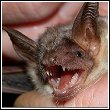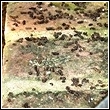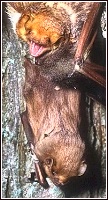
Bat Facts
The interesting facts about bats that you'll find here are not only fun, but are beneficial to know too. That's because there are perks to having bats living near your home - just as long as they are outside. Understanding their habits is the first step toward co-existing and enjoying the benefits that come with it.
Eating, Breeding And Seasonal Habits
Bats are dangerous to have in the house, however, they can be quite beneficial outside the home - and that's a fact. And so are these ...
Eating Habits
Bats are a great source for affordable mosquito control, as a matter of fact, just one bat will consume thousands of mosquitoes every night.

This love of insects has given the Mexican free-tailed bat a reputation for being known as the "farmer's friend". This nickname came about because bats eat moths that otherwise might destroy the farmer's crops.
Breeding And Seasonal Habits
- Bats breed in the fall and have babies, called pups, in the spring.
- Bats are live bearing mammals, in fact, they are the only mammals capable of true flight.
- As shown in the photo above, bats typically roost together with their pups, separate from the males.
- Mothers sometimes carry pups on their backs.
- New pups start to grow hair at several weeks, but will not be able to fly for at least four months.
- Babies must be able to fly before bat exclusion can work, seasonally restricting when attic bat removal can be done.
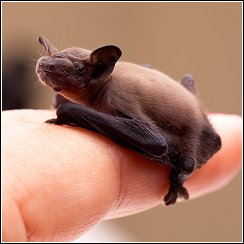
Regarding seasonal activity, some bats hibernate during winter months, some utilize a semi-hibernative state called torpor, and others migrate to another location. Brown bats often "wake up" and move about in the middle of winter when warm spells occur. The Wildlife Whisperer gets a lot of calls during these times.
Bat Anatomy
Bats have a physiology and appearance all their own designed to allow them to fly and hang upside down.
In fact, they are the only mammal capable of true flight.
It is the membrane running between their fingers that enables bats to fly.
Below is a diagram that shows how a bat's wing might be compared to a human hand with respect to where the arm, elbow and fingers might be.
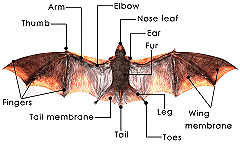
Bats have an interesting anatomy overall, including large ears designed to help with echolocation and very good eyesight to help them hunt in the dark. Similar to sonar, echolocation is the location of objects by reflected sound. A bat can tell how far away something is by sending out a sound and seeing how long the sound takes to return to them. Due to this ability, it is often assumed that bats are blind, when in fact they are not.
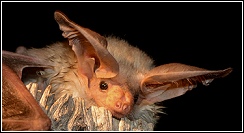
Bats also have a good sense of smell that helps them identify food and other bats in the colony. Nectar seeking bats also help with pollination by carrying pollen on their nose between flowers and plants.
As shown by the incredible photos in this National Geographic article, "Call Of The Bloom", some flowers reflect sound to help bats find them - this helps ensure propagation of that particular variety of plant species.
Bats have very strong claws that enable them to rest by hanging upside down. The anatomy of their claws, feet and tendons is designed specifically to allow their claws to lock into place without a conscious effort so they can hang or roost while they sleep. As a matter of fact, a bat can remain hanging even after it has died.
The photo below of large flying fox megabats in Bali illustrates a bat's hanging abilities and the membrane running between the fingers very well.
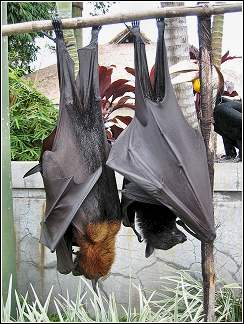
as they roost and rest during the day
This particular genus of bats can have a wingspan reaching over 3½ feet and is the largest bat in the world. The flying fox does not use echolocation like the insect eating bats of North America do, but rather they utilize a well developed sense of smell and keen eyesight to find and feed on fruit, nectar, blossoms and pollen. They can be found in Australia, and throughout Southeast Asia, but many varieties have been hunted close to extinction and are now considered an endangered species.
Like most other mammals, bats have fur that helps keep them warm. The color of a bat's fur also serves as a kind of camouflage.
For instance, when a Red Tree Bat hangs from the branches of a tree they could easily be mistaken for a leaf!
Although a bat's anatomy enables it to fly, their "wings" don't necessarily provide enough lift to take off from a grounded position like a helicopter might, and their feet are designed for hanging instead of running, so utilizing speed to take off like an airplane isn't an option either.
Consequently, bats have to take flight by dropping and gaining lift from the air below them by spreading their wings as they do so - similar to how a hang glider takes flight. So, sleeping high up in a hanging position enables bats to drop and take flight quickly should a predator approach.
As a matter of fact, the bat's entire anatomy is designed around an ability to effectively hunt, hide, climb, rest and escape as needed.
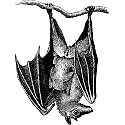
a hanging state
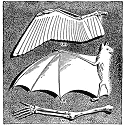
a bird's and a human hand.
South Of The Border
- The Vampire Bat -
There are over 1,100 species of bats throughout the world ranging in habitat, size, color and diet. But, the vampire bat is perhaps the most famous of all. Vampire bats tend to be "scary" because of their feeding habits and "the fact" that they live off the blood of other animals.
And the Dracula movies haven't helped much either.
Vampires have a specialized anatomy that other bats don't have, one that is designed around their feeding habits that includes heat sensors and sound processors to locate victims, razor sharp teeth for penetrating hides, and, a substance in their saliva known as Draculin that prevents the bite wound from healing until the vampire has completed feeding.
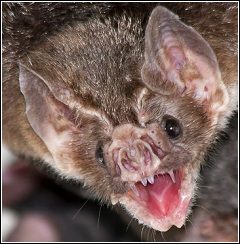
Common hosts include sleeping cows and other mammals. Vampire bats like to approach from the ground and can walk, run and hop to stalk their prey. The good news for Oklahomans is that vampire bats are mainly found outside the United States in Mexico, Central and South America.
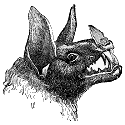
a vampire profile

illustration
These are just a few of the interesting facts about bats. Should you wish to explore further, we have additional helpful information for you on these incredible animals, including more about bats and rabies, bat removal and how a bat box can help with mosquitoes around your home.
1242 SW Pine Island Rd., Suite 310
Cape Coral, Florida 33991-2126
help@totalwildlifecontrol.com



